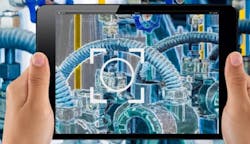Related to
Latest from Automation/AI/AR/VR/Chatbots
Metaverse Investment = YOUR Future
What Today’s Investment Levels in the Metaverse Tell Us About Telecom Business Strategies
The business world is clearly transforming before our eyes. E-commerce and mobile communications reshaped the way telecommunications manufacturers and network providers operate, and now the metaverse is transforming our lives all over again–for large businesses in particular. But there are also great potential benefits for businesses of all sizes. By enabling a virtual presence that’s cost-effective and more immersive than traditional methods, the metaverse is poised to become a key player in the global economy.
The metaverse will allow telecommunications companies to create their economies, exchange goods with other companies, design new products and engage in virtual customer site visits, and form partnerships in new and innovative ways.
…manufacturing executives and business leaders feel they will get the most out of the metaverse through AI and Software (57%), Marketing Automation (48%), Workflow/BPM (39%), AR/VR (27%), Project Collaboration (23%), and Robotics (17%).
This will all be accomplished through “digital twins”–a virtual world where people, consumers, and employees all gather to communicate, collaborate, and share through a virtual presence on any device. This means companies will build immersive virtual spaces, aka metaverses, and it will allow employees to virtually collaborate using their digital twin through chats, emails, video calls and even face-to-face meetings–each of which will have a positive impact on overall network performance.
Many telecommunications businesses have already begun making investments, and in fact a recent survey1 of manufacturing and operations decision makers revealed that a third of them said nearly a quarter of their operations leveraged AR/VR in 2021. This signals growth in 2022 since 50% of them said they would increase their use of AR/VR in roughly half of all operational projects this year.
Nearly a third (29%) said they would be interested in leveraging the metaverse but they need more innovation to build custom solutions. Forty-five percent either strongly agree or somewhat believe the metaverse will be beneficial toward their operations.
Furthermore, manufacturing executives and business leaders feel they will get the most out of the metaverse through AI and Software (57%), Marketing Automation (48%), Workflow/BPM (39%), AR/VR (27%), Project Collaboration (23%), and Robotics (17%).
Meta-Heavy-Lifting
For many leaders, the metaverse will require heavy investment and a shift in numerous modes of business, as well as an understanding that there will continue to be a fundamental change in the way business is conducted in the future. The power of simulation will be a game-changer for enterprises and businesses throughout the metaverse in a variety of industries, such as optimizing production planning in the automotive sector, accelerating design in the aerospace industry, improving overall production efficiency for manufacturers, while increasing accuracy for consumer-packaged goods companies. Many companies are poised to leverage virtual simulation to make better business decisions and generate the greatest return on investment.
In the metaverse, B2B sellers can create more immersive buyer experiences, and these virtual interactions have the potential to generate new and more sales opportunities compared with traditional advertising and buyer engagement scenarios.
Fueled further by the pandemic, many companies realize the power that a virtual environment now has on internal operations as well as customer interactions. However, they’re realizing that virtual interactions on platforms like Zoom are no longer enough to truly create the proper engagement they desire.
Enterprise sales teams struggle to consistently communicate with differentiated value when the solution is complicated. Therefore, an immersive virtual environment leveraging digital twins can offer the right experience for customers, engage with design teams and even test different product applications without real-world applications.
This means companies will build immersive virtual spaces, aka metaverses, and it will allow employees to virtually collaborate using their digital twin through chats, emails, video calls and even face-to-face meetings–each of which will have a positive impact on overall network performance.
The metaverse is going to be important for all businesses, enterprises and consumers. Today, people and employees can only experience the Internet when they log online on their computer or mobile device. With this new form of connectivity, devices and technologies powered by immersive mixed reality, will allow users to experience the Internet all around them every single day.
While it could take some time, these tools and related increased investments will force companies to transform their businesses forever.
REFERENCES AND NOTES
1. GridRaster survey of more than 2,000 business leaders on AR/VR and metaverse investment levels; December 2021. https://www.digitalengineering247.com/article/survey-shows-how-manufacturers-plan-to-leverage-metaverse/prototype
ABOUT THE AUTHOR
Dijam Panigrahi is Co-Founder and COO of GridRaster, Inc., a leading provider of cloud-based AR/VR platforms that power compelling high-quality AR/VR experiences on mobile devices for enterprises. For more information, please visit https://gridraster.com/. Follow GridRaster on Twitter and LinkedIn @gridraster.

Dijam Panigrahi | Co-Founder and COO of GridRaster, Inc.,
Dijam Panigrahi is Co-Founder and COO of GridRaster, Inc., a leading provider of cloud-based AR/VR platforms that power compelling high-quality AR/VR experiences on mobile devices for enterprises. For more information, please visit https://gridraster.com/. Follow GridRaster on Twitter and LinkedIn @gridraster.








